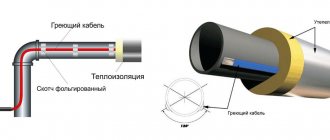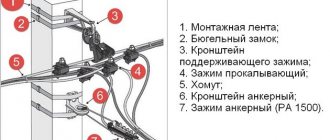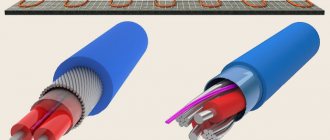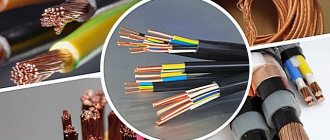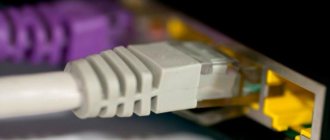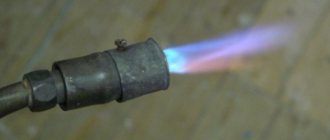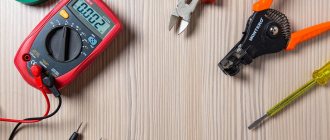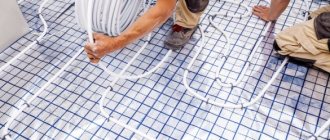We all know that when the water supply freezes, we are in big trouble. Icicles that form inside pipes can sometimes reach several meters in length. To remove the resulting traffic jams, specialists need to make every effort. If you live in a region where harsh winters prevail, you need to think about this problem in advance.
Conventional thermal insulation will not save pipes during prolonged frosts. You need to additionally insulate the pipes. In this case, a self-regulating heating cable for water supply will help you, which will independently maintain the required temperature. The wire will not only provide heating of the pipes, but will also prevent the formation of condensation.
Application of wire for heating pipes
To heat water supply and sewerage systems, specialists have long been using special heating elements . What is the difference between a heating cable? It is a regular cable, but its heating is controlled by adjusting the resistance.
Heating wire for plumbing systems is used to prevent water from freezing at sub-zero temperatures in those sections of pipes that run along the street. As a rule, it is turned on when the air temperature drops to 5°C. This is done so that it protects the water pipes from freezing in the event of further cold weather. If the heating element is turned on when the temperature is already below freezing, it will take some time to defrost the already frozen water. While the water is melting, the water pressure will be very low.
Warmly bright
Reason No. 1: mechanical damage to the heating cable
Self-tapping screws on the floor, scattered foreign construction materials, abandoned tools, working in hard shoes, etc. – all these elements of sloppiness often do not lead to immediate damage, but appear over time. Some of such damage can be detected after laying heated floors by measuring the insulation resistance with a megohmmeter. Let's note the damage associated with the work on laid heated floors and tiles - drilling holes for plumbing, door bumpers, thresholds, etc. This often happens due to the lack of installation diagrams and installation photographs.
Repair of underfloor heating cable damaged during toilet installation. pic.twitter.com/qvWi3jgyuh
— Teplosvetlo (@teplosvetlo) May 5, 2021
Small distance between cable turns
Reason No. 2: failure to comply with the requirements for the distance between cable turns and the minimum bending radius
Another reason for the premature failure of heating cables is failure to comply with the minimum permissible distance between the cables and the bending radius, see photo. This distance is always indicated in the user manuals of serious manufacturers; as a rule, it is 5-6 cable diameters. When this distance is reduced, often due to the negligence of installers or tilers, local overheating of the heating cable occurs, followed by its failure.
Reason #3: “shortening” the heating cable
Some installers, if there is excess heating cable left, simply cut off the excess, wrapping the ends with electrical tape. Such masters do not realize that this leads to a significant increase in power and overheating of the cable.
It happens that the heating cores themselves are connected to the thermostat. This is strictly prohibited in any instructions for installing heated floors. Any damage to the cable during installation or tiling must only be repaired by a qualified technician.
Reason #4: overheating due to “blocking” the heating cable with furniture
The reason that caused damage to the heating cable may be local overheating due to the location of the heating under stationary furniture without or with short legs, under carpets, etc. This point is indicated in all instructions for installation and operation of heating cables.
Reason No. 5: intersection of the heating cable with materials of different thermal conductivity
The passage of a heating cable in a screed or tile adhesive through materials with a thermal conductivity that is sharply different from the base material - wooden embedded parts, plastic pipes (including corrugated pipes for floor temperature sensors), etc. - is another reason for the gradual destruction of the cable. In the photo provided by our colleague Yuri Antonov, a fairly common mistake is installing a heating cable under a tube with a floor temperature sensor.
Reason #6: destruction of couplings
Heating cable coupling
One of the most common causes of failure of heating cables is damage to the couplings, i.e. the places where the heating cores and a regular electrical cable are connected are the “cold ends”. In this place, over time, oxidation of the contacts occurs, which leads to the destruction of the coupling. This is especially typical for anti-icing systems, in which the cable and couplings are subject to additional exposure to changing temperatures, moisture, and mechanical stress.
Reason #7: Damage to the cable sheath during installation at too low temperatures
Installation of heating cables should not be carried out at low temperatures (the minimum is indicated in the installation instructions), usually below +5°C. If this condition is not met when installing heating for balconies, unheated rooms, and anti-icing systems during the cold period, damage may occur, first of all, to the sheath of the heating cables, which becomes more fragile at low temperatures. The short-term switching on of unwound cables, recommended by a number of manufacturers, should be done with caution.
Reason No. 8: overheating due to the cable being pressed into the thermal insulation
When installing a heating cable on thermal insulation, it is necessary to prevent the cable from being pressed into the latter to improve heat dissipation. To do this, the cable can be secured, for example, using tie clamps to a reinforcing mesh, which is raised approximately 1 cm from the thermal insulation.
Reason #9: overheating due to constant operation
The reason for the failure of the heating cable may also be a breakdown of the thermostat (thermostat), leading to constant heating and overheating of the cable. In order to save money, it is not recommended to use simple switches instead of thermostats. This is especially true for powerful main heating systems.
Reason #10: cable overheating during “check”
When checking its functionality, the heating cable (mat) can only be connected to the network in an unwound state. In the absence of screed (adhesive solution) for a short time - 5-10 minutes. Failure to follow this simple rule will damage it.
Reason No. 11: overheating of the cable due to air voids in poorly dried mixtures or improper laying of tiles
For a cement-sand mixture, the period of complete drying, after which the formation of air bubbles is no longer possible, is 28 days, for adhesive solutions 7-10 days. When turned on early, when the mixtures have not completely dried, microvoids are formed, which subsequently lead to overheating and damage to the cable. These same voids (air “pockets”) can be formed when pouring thick DSP or improperly laying tiles. The result is the same cable damage.
Reason No. 12: the manufacturer’s failure-free operation life of the heating cable has expired
We have already written about the lifespan of heating cables in the article Manufacturer’s Warranties and the service life of electric heated floors. Sometimes you can extend the life of such a system by local cable repairs. At the same time, it is worth planning a complete replacement of the heating cable.
Reason No. 13: factory defects
Factory defects are a fairly rare occurrence among serious manufacturers. Heating cables undergo multi-stage testing after manufacture. But if marriage does take place, its consequences, as a rule, do not appear immediately. We have had to deal with similar cases several times. The supplier companies agreed with our conclusions on this matter and some compensation for financial losses was made.
If the heating cable (mat) fails, you should contact qualified specialists who, as a rule, using appropriate instruments, find the location of the damage with high accuracy, open the coating at the location of the damage, connect the broken area using crimp sleeves and heat-shrinkable sleeves, restoring thereby the integrity of the cable (mat). Go to the section Repair of heated floors.
Is your underfloor heating broken? Our craftsmen will repair underfloor heating quickly and for a long time! Enter your contact information in the feedback form or call tel. 309-7-123 from 9:30 to 21:30 any day, seven days a week!
How does a heating cable for water supply work?
The heating wire consists of two conductors - hot (heating) and cold (electric), a plug and a temperature limiter. The conductors are connected to each other by laser soldering.
The water heating element is 100% protected from moisture, because... its external insulation is seamless. Insulation also protects the cable from chemical attack and high temperature. The temperature limiter acts as a pipe temperature regulator; it turns off the power when the temperature rises to 15°C. Power is restored when the temperature drops to 5°C. This ensures maximum energy savings.
Food and non-food - 3 differences
Self-regulating cables are divided into food-grade cables, which can be laid directly into the pipe, and non-food-grade cables, which can be laid on top.
How do they differ from each other structurally? Firstly, the size.
Food grades, with fairly similar characteristics, have a smaller cross-section so as not to occupy useful space inside the water supply. Compare, the most common dimensions for external ones are 7*14mm, 7*15mm, and for internal ones – 5*7mm.
Mistake #4
You can't go wrong with the size, and such a cable can actually reduce water pressure.
At the same time, do not forget about the end coupling, which has a cross-section 1.5-2 times larger than the wire itself.
The second difference is the mandatory presence of a screen. External ones may not have it.
And thirdly, and most importantly, the external insulation material.
Here, for example, is a food option.
On the outside we have:
- fluoropolymer shell
This shell is chemically inert to aggressive environments and does not decompose inside the water supply.
Next come:
- armored, protective screen or braid
Mistake #5
Without such a grounding screen, the cable inside the pipe cannot be used.
- insulation layer
- two copper strands with a polymer between them
For the non-food model, the shell consists of ultraviolet-resistant polyolefin.
Scope of application of heating cable
It is worth noting that in the past this type of wire was used only for heating pipes in industry . Today, heating cables are more widely used; they are often used in households, cottages and private houses.
Let's look at the advantages of using heating wire for water pipes:
- Reliability. Professional installation and proper calculation will help prevent water from freezing in the pipes throughout the entire period of operation.
- Versatility. The heating wire is self-regulating; you can connect it to pipes located not only underground, but also outdoors. The wire can be laid inside the pipeline and outside.
- Safety. Heating cables are often used to heat drinking water pipes.
- Economical. Depending on the air temperature, the heating power is adjusted, which saves energy consumption.
- Ease of use. The cable is activated quite simply: it is attached to the water supply network and then plugged into a socket.
The pipe is frozen - the reason
All heating cables operate normally only if the voltage corresponds to the nominal values specified in the product data sheet. If you have problems with the voltage at home, and it rarely rises above 180-190V, then do not be surprised that the selected power may not be enough, and one day the pipe will freeze.
Why does the cable itself sometimes die? Self-regulators are afraid of frequent switching on and off. They usually have a finite number of such switchings.
They also fail due to improper connection to the 220V power cable. Poor quality end seal and moisture getting into the shell are another reason.
To seal the food cable into the pipe, seals are used. When choosing them, pay attention to the shape of the cable. They are round or flat.
They use their own seal for a specific brand. If you choose the wrong one, you will get a leak.
Types of heating cable
The types of heating wires for water pipes are quite varied . According to the heat dissipation pattern, they can be divided into resistive wires, mineral insulated wires and self-regulating ones.
Resistive heating cable can be linear or zonal. Linear wires are distinguished by the fact that they generate heat as current passes through the heating core. In turn, the wire can be double or single core. The wire can also have several strands in a spiral or linear shape. It is unacceptable to arbitrarily cut such a cable.
In its design, a self-regulating heating cable has similar features to a resistive cable . It also consists of two conductors that conduct current, but there is no insulating coating. Along the entire length of the cable, heat dissipation can change: when the outside air temperature rises, the resistance of the polymer increases and heat dissipation decreases. The self-regulating function helps prevent overheating and burnout of the product. This type of wire can be cut into sections from 20 cm to several meters in length.
Criterias of choice
When choosing a heating cable, the following parameters must be taken into account:
- Pipe diameter, especially if internal heating is planned.
- Insulation materials and thickness.
- Estimated heat loss.
- The region in which the pipeline is located. The further north you go, the more powerful the cable is required, or you will have to select serious insulation with a thickness of at least 30 mm.
In the middle zone, a power of 10 W/m is enough, in the northern regions you need to buy from 17 W/m.
It makes sense to install a thermostat and sensor so as not to pay extra. For example, resistive cables will work even when the outside temperature rises above zero. A self-regulating cable for heating a water supply usually turns off at +13 degrees, but if water is supplied from a well, its temperature will always be lower, even in summer. In autumn and spring, it makes no sense to heat water, which in the house still goes through the heating stage in a boiler or boiler.
The advantage of the thermostat is that the cable will not work for too long - it has its own specific resource and will last longer. It is enough to set the regulator so that the cable is disconnected at a temperature of +5 degrees. Under such conditions, the liquid will not freeze, and the pipes are not in danger.
Cable installation
Insulating water pipes is a complex process that cannot be delayed. This is exactly what a heating cable is used for. The heating temperature of the wire can be changed by changing the resistance value. It is permissible to install a heating cable both outside and inside the pipe. Regardless of the installation location, the wire is selected so that heat loss in the water pipes does not exceed the amount of heat released in the system.
Installation of heating cable for water pipes
There are two installation options: you can lay the cable in a spiral or in parallel rows . The wire is secured using adhesive tape or a tightening metal mesh. To achieve the maximum heat preservation effect, the pipe with the heating cable can be wrapped on the outside with foil. For a competent process of installing a heating wire, of course, it is better to seek help from specialists. In this case, you will be absolutely sure of the correctness of the work performed.
Pipe mounting with valve
What if you have a more complex case? For example, are there fasteners and valves on the water supply section?
There are certain nuances here. First, prepare the pipe itself by gluing the tape.
At the fastening points, the clamps will have to be temporarily removed.
In this case, the wire itself must pass through the lower attachment point of the clamp.
What to do with the tap?
Mistake #10
If the cable is pulled here in a straight line or even in a spiral, then if it is necessary to replace the valve, it will no longer be possible to do this without cutting the cable.
Therefore, a reserve must be made in the form of a loop.
After this, simply fold this loop around the valve and tighten it with a tie.
Thermal insulation is stretched over everything.
Typical calculations of heat loss from the surface of a pipeline
Calculated heat loss, Qv, W/m (with a thermal conductivity coefficient of thermal insulation of 0.05 W/m (m' °C) – corresponds to mineral wool type insulation.
This table is applicable both for heating outside and for heating inside the pipe.
For example: A pipeline with a diameter of 159 mm, insulated with thermal insulation 50 mm thick, at a minimum ambient temperature of -25 ° C and the required temperature of + 5 ° C, we obtain a difference of 30 ° C; according to the table, this value of heat loss power will be 18.82 W/m. The power of the selected cable must be no less than the detected heat loss power.
Cable powers are traditionally standardized at 10/16/24/30/40 W/m. Thus, to heat the pipeline given in the example, a cable with a power of 24 W/m is suitable. The length of the cable section depends on the length of the pipeline and the presence of additional heated elements (turns, tees, shut-off valves, etc.).
Most often, household pipelines are heated with a single-strand cable. In some cases, spiral winding of the cable on a pipe or heating with 2 or more threads is used (typical for large-diameter pipelines).
Connection and thermal insulation
The connection technique is universal, regardless of which wire is used, but there are nuances. The installation of the heating cable is completed by insulating the ends and connecting them to devices and sensors. To work you need to use the following equipment:
- knife;
- pliers;
- side cutter;
- construction hairdryer
First you need to prepare the cable. This will require additional terminals that come with the wire or pipe. Inside the sleeve has a special heat-shrinkable layer that improves the quality of the connection. Instead of a terminal, a special plug can be used. Only after this the end coupling is installed. To do this, first cut off a few centimeters of the outer insulation, then remove the braid, string the sleeve and heat it with a hair dryer so that shrinkage is successful. To be sure, the terminal should be clamped for a few seconds with pliers.
An example of cable installation inside a water supply system Source www.ingeneriya.ru
Resistive cable for pipeline heating
A constant power (resistive) cable has a certain power and does not have the ability to self-regulate. The thermoregulation function is performed by a temperature sensor located on the surface of the pipeline and a thermostat connected to the heating system. Most often, resistive cable is used for industrial heating.
This cable is sold only in ready-made sections of a certain length and changing the length of the section is strictly prohibited (the cable will simply stop working). For domestic heating, there are also ready-made sections that have a thermostat (bimetallic thermostat) located at the end of the cable section. At temperatures below +3°C, it turns on the heating section and turns off when the temperature reaches +10°C.
Advantages of resistive cable
- Maintaining high temperature characteristics of heated pipelines and objects.
- Warming up of products in pipelines and starting pre-heating.
- High specific heat release.
- Constant heating power regardless of temperature changes, which is widely used for heating systems of objects.
- Stable characteristics throughout the entire service life.
- Low price.
Disadvantages of resistive cable
- The cable is afraid of local overheating.
- Difficulty in managing the system.
- The fixed length of the section creates difficulties during installation.
We deliver cable anywhere in Russia!
In what cases is water heating used?
An ideally designed water supply system, laid below the freezing depth of the soil and insulated with thermal insulation, does not require heating. According to SNiP 2.04.02-84, the pipeline must be laid 0.5 m below the freezing depth.
When the pipeline is buried in the ground above the mark of 1.8-2.0 m for central Russia (the freezing depth varies for different regions of Russia), the water supply system needs heating.
Even in the case of short-term freezing of the soil, the formation of ice plugs or narrowing of the pipe lumen is possible, which in the future can lead to the destruction of the pipeline. This problem is especially difficult to resolve if freezing occurs in a section of an underground pipeline - there is no way to warm the pipe in the usual ways: using hot water or a hair dryer.
Types of thermal cables for water supply
They sell heating cable products in coils (sections) of a certain length. The kits are designed for a fixed surface area - they cannot be reduced or lengthened.
Features of heating conductors:
- the length of the connecting sections is 0.75 - 2.0 meters (varies from different manufacturers), this is enough to connect the cold ends in the junction box;
- for connections, connecting couplings , which must be of high quality;
- The color of the braid depends on the power, the cables are marked, and the sections have separate instructions indicating the parameters and method of installation.
The system includes : a cable with fastening accessories for fixing on the pipe, information and power wires, a distribution box, control cabinets or panels, sensors, temperature and flow controllers.
The choice depends on factors:
- route functionality;
- characteristics of the transferred product;
- conductive flow intensity;
- external conditions.
If the circuit has an adjustable thermostat, the power can be reduced by half.
At the place of installation
There are different methods for installing heating cables:
- On the outer surface of the pipe. A simple option means fixing it to the collector along the entire length of the section that is protected from freezing. More efficient heating is achieved by wrapping the cable along the pipe in a spiral - this increases the contact area. The conductor is secured with clamps and self-adhesive tape, and thermal insulation with an internal reflector (a layer of foil) is placed on top of the set.
- Inside the pipeline. The cable works more efficiently, but reduces the channel diameter and reduces throughput characteristics. In long pipes it is difficult to stretch the internal cable while maintaining integrity. Additional couplings for sealing, gaskets, tees will be required, and pressure testing of the water pipeline can only be done by a specialist. If the cable malfunctions, you need to disassemble the system from start to finish.
Valera
The voice of the construction guru
Ask a Question
If the length of the section and conductor does not exceed 80 meters, current is supplied to the system by plugging the plug into the socket. For longer lengths, an isolation transformer is needed; RCDs and circuit breakers are provided in the main line.
According to the operating principle
Resistive cables are represented by two steel conductors in the shape of a spiral with insulation. Inexpensive products are produced in various fixed lengths, which almost always cannot be cut.
Types of resistive cable:
- single-wire ones are connected at both ends - less length required, budget option, no inrush currents, constant power;
- two-wire ones are connected to the shield at one end, and at the other end the joint is short-circuited and insulated;
- a zone (sectional) cable has two thin conductors with low resistance, and short sections of spiral heaters are placed between them - the option is more expensive, it can be cut and connected at one end.
A self-regulating heating cable consists of two conductors without insulation, which are embedded in a plastic sheath. The resistance of the PVC braid changes and depends on the temperature, so the wire regulates the power independently at each point.
A self-regulating cable is produced with adjustment to the selected temperature; its properties are determined by two indicators:
- power p/m at +10°С;
- product power in water or ice.
Self-regulating options are cost-effective, reliable, and can be cut into the required lengths. If moisture gets in or condensation appears, the wire may become unusable.
Section assembly
- What is needed to organize heating of pipes using a heating cable with a self-regulating matrix?
To begin with, turn it into a ready-made heating section. For this you need:
- Power wire (the so-called cold end). For a heater with a shielding shell, a three-core wire 3x1.5 mm2 is used;
- Eurofork;
Grounding Plug
- Installation kit, including heat shrink of several sizes and sleeves for connecting wires. Its price currently (2017) varies from 200 to 400 rubles.
How to assemble a section with your own hands?
Here are the detailed instructions:
